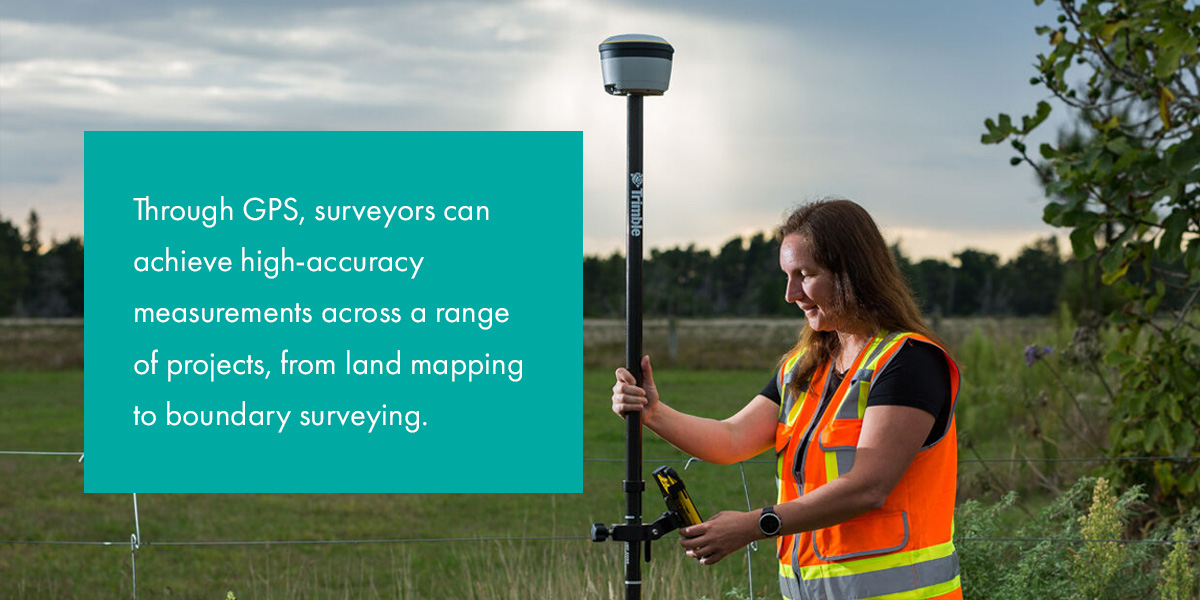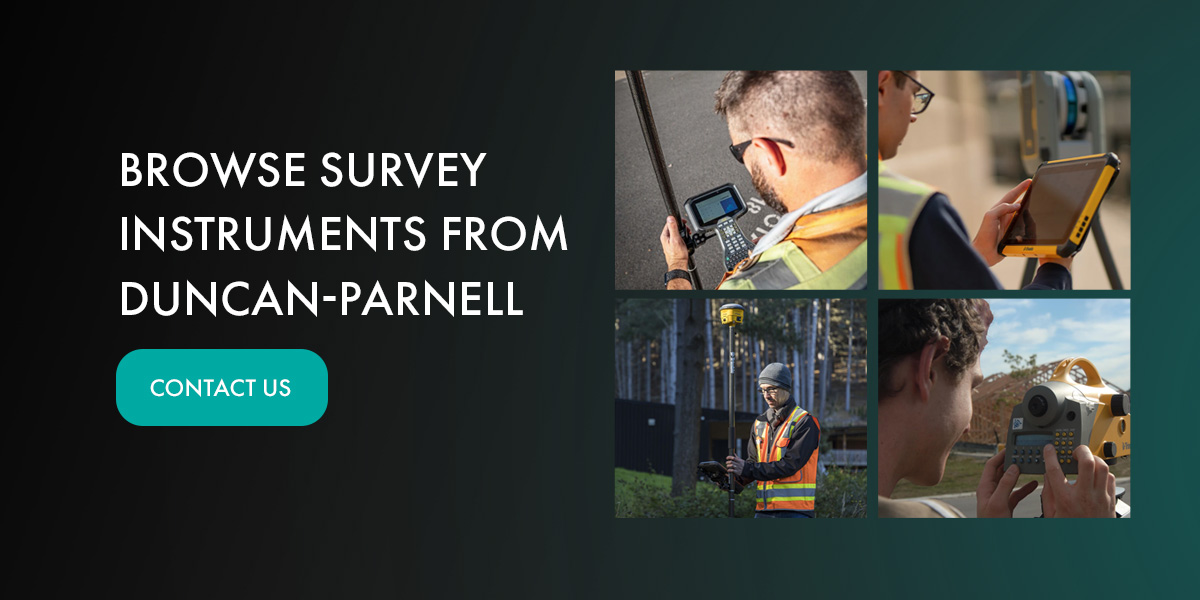Essential Survey Supplies & Accessories
Surveying requires great attention to detail, accurate measuring and data interpretation. The right equipment can make all the difference in the complex surveying process, which can involve numerous tools, gear and technology.
Understanding your options and what types of survey equipment fit your needs best can help you boost productivity and improve project outcomes.
3 Must-Have Surveying Equipment Options
Whether you're part of the communications field or work in construction surveying, some equipment is more crucial than others. The following are the three main kinds of equipment that almost all survey operations should feature.
1. Total Stations
A total station measures angles and distances to determine the position of points in three-dimensional space. These instruments combine the abilities of a theodolite to measure angles and an electronic distance measuring (EDM) device to calculate distances.
With a total station, you get precise, accurate measurements with real-time feedback. This data can help you make quick adjustments in the field and informed decisions after the work is complete, thanks to the collection, processing and analysis features available on many modern devices. It's easy to transfer total station data electronically or integrate it with a geographic information system (GIS).
Typically, total stations are used for topographic surveys, site planning, and boundary surveys. When even more precise positioning is required, such as for civil engineering purposes, they can work alongside Global Positioning System (GPS) technology to provide insights.
2. Levels
During construction projects, leveling is essential to ensure all structures are built with accurate elevation in mind. With levels, surveying teams can find the height of a point relative to a reference point and determine an area's slope. These tools are also helpful for mapping out horizontal lines.
While some simpler, traditional levels use liquid-filled tools with air bubbles to measure horizontal lines, modern instruments feature laser beams and self-leveling abilities. Today's levels are easy to use on multiple project sites and in various weather conditions.
Some of the most common survey levels include:
- Dumpy level: This popular surveying instrument includes a telescope mounted on a tripod. Its rigid, fixed construction helps ensure accuracy. Once the level is set up properly, the operator adjusts the telescope's focus, rotates the circle until it aligns with the desired point, and reads the scale to take the measurement.
- Wye level: Also called a “Y level,” a wye level works similarly to a dumpy level but comprises a telescope set inside two Y-shaped supports. These supports allow the operator to move the telescope around its longitudinal axis. It can also be detached. This design is ideal for measurements requiring quick recalibration, as operators can move and turn the telescope rapidly.
- Reversible level: This level offers features of both the dumpy and wye levels. The telescope sits in two attached upholds, and it can be inserted and secured from either end. When fastened, it performs like a dumpy level with precise stability. One key benefit is that the operator can eliminate collimation errors by reversing the telescope and detecting small mistakes in alignment.
- Automatic level: An automatic level uses a compensator or stabilizer to automatically establish a horizontal line of sight. The telescope is fixed, making it similar to a dumpy level in terms of design. That said, the compensator can provide even more precise leveling by responding to gravity and stabilizing the line of sight even when the tool is not level.
3. GPS Receivers

One of the most notable advances in modern surveying is the use of GPS tools, namely receivers. Through GPS, surveyors can achieve high-accuracy measurements across a range of projects, from land mapping to boundary surveying.
GPS receivers can supply real-time positioning data, sometimes within a few centimeters, particularly when using real-time kinematic (RTK) systems. To use a GPS receiver in surveying, the operator sets up the receiver at a known point and records the GPS coordinates. This data allows the operator to find points relative to the known point.
Depending on the project, an operator may use static positioning to gather data over an extended period of time. If the survey is more complex, an RTK system can collect data with a moving unit that transmits real-time corrections to the receiver.
Essential Survey Accessories
Apart from essential survey supplies, you may want to explore different survey accessories and tools to streamline your workflow and achieve even more exact results. Here are some ideas:
- Tripods: A durable, well-made tripod can make all the difference in your surveying capabilities. This tool is fundamental for a total station or level to work properly. Consider different material options and points, as some may be more suitable for your work than others. For example, metal points are ideal for stabilization in outdoor environments.
- Prisms: A prism reflects signals from an EDM device, such as in total stations, to measure angles and distances. Having durable prisms for your land surveying projects can help you improve accuracy.
- Measuring tapes and tools: More than anything, surveying is all about measuring. Ensure you have basic measuring tools like fiberglass tape, pocket tape and folding rulers on hand to complete your work.
- Data collectors and field books: Today's hand-held data collectors make it easier than ever to gather accurate results in geospatial division. If your project requires General Services Administration-approved equipment, you can find an array of suitable data collectors from notable brands. Consider data collector accessories like batteries and screen protectors to get the most out of your gear. When you need a quick way to write down field notes, a field book is the perfect tool to have ready.
How to Choose the Best Surveying Instruments
While almost every surveying job will require ground-based measuring tools like total stations and levels, you can still consider a few different factors to help you select the right equipment for the job. Asking yourself and your team the following questions can help:
- Project type: What kind of project are you working on? Will you need to make highly accurate measurements that require more advanced equipment? Will you need access to specialized systems like mobile mapping solutions?
- Budget: Does your budget allow for long-term investments in high-quality gear? Look for well-made equipment and accessories from leading industry brands to give you the best value for your money.
- Features: What kind of capabilities and functions should your field equipment perform? Do you need more modern surveying gear to complete complex tasks? Will you need to move the tools frequently throughout the project site?
- Integration: Can the equipment you're researching integrate with your existing software, including your GIS? Is it compatible with the accessories you already have? Will you need to change anything about your current workflow to adopt the equipment?
- Use: How easy is it to use the instrument? Will you or your team need training before deploying it in the field? Does the tool come with support options from the manufacturer or supplier?
Browse Survey Instruments From Duncan-Parnell
If you're ready to find high-quality, essential surveying supplies and accessories, Duncan-Parnell is here to assist. With decades of experience, we've been the positioning equipment provider of choice for surveyors, engineers, architects, and other professionals in need of geospatial and unmanned solutions. Whether you're interested in surveying gear for sale or rent, we also provide service, training and support on all of our inventory.
Browse durable, industry-leading options from Trimble and other manufacturers to find the equipment you need. Have questions or inquiries? Reach out to our team today to get in touch.


